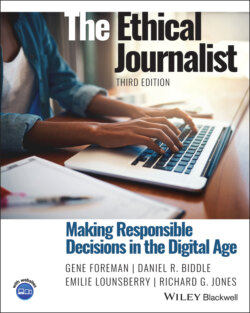Читать книгу The Ethical Journalist - Gene Foreman - Страница 16
Learning Goals
ОглавлениеThis chapter will help you understand:
why ethics is vitally important in a journalist’s everyday work;
why responsible journalists adhere voluntarily to high standards of conduct;
how journalists should make ethically sound decisions;
how discussing the case studies in class is crucial to learning the decision-making process; and
how the digital era, in revolutionizing the way the news is gathered and delivered, has made a common language of ethical standards more essential than ever.
LOVELLE SVART, a 62-year-old woman with short, sandy hair, faced the video camera and calmly talked about dying. “This is my medication,” she said, holding an orange bottle of clear liquid. “Everyone has told me … I look better than I did ten years ago, but inside, I hurt like nobody’s business.” On that afternoon of September 28, 2007, after she had danced the polka one last time and said her goodbyes to family and close friends, the contents of the orange bottle quietly killed her. 1
Svart’s death came three months after her doctor informed her she would die of lung cancer within six months. The former research librarian disclosed the grim prognosis to a reporter friend at The Oregonian in Portland, the newspaper where she had worked. She said she had decided to avail herself of Oregon’s assisted‐suicide law. Svart also said she wanted to talk to people frankly about death and dying, hoping she could help them come to grips with the subject themselves. Out of that conversation grew an extraordinary mutual decision: On its website and in print, The Oregonian would chronicle Lovelle Svart’s final months on earth.
In her series of tasteful “video diaries,” she talked about living with a fatal disease and about her dwindling reservoir of time. In response, hundreds of people messaged her on the website, addressing her as if they were old friends.
But before Svart taped her diaries, journalists at The Oregonian talked earnestly about what they were considering. Most of all, they asked themselves questions about ethics.
The threshold question was whether their actions might influence what Svart did. It is not unusual for journalists to worry about doing something that could change the story they are covering. In this case, however, the stakes could not be higher. Would Svart feel free to change her mind? After all the attention, would she feel obligated to go ahead and take the lethal dose? On this topic, the Oregonian journalists were comforted by their relationship to their story subject. Familiarity was reassuring, although in the abstract they would have preferred to be reporting on someone who had never been involved with the paper. In 20 years of working with her, they knew Svart was strong‐willed; nobody would tell her what to do. Even so, the journalists constantly reminded her that whatever she decided would be fine with them. Michael Arrieta‐Walden, a project leader, personally sat down with her and made that clear. The story would be about death and dying, not about Svart’s assisted suicide.
Would the video diaries make a statement in favor of the controversial state law? No, they decided. The debate was over; the law had been enacted and it had passed court tests. Irrespective of how they and members of The Oregonian’s audience felt about assisted suicide, they would just be showing how the law actually worked – a journalistic purpose. They posted links to stories they had done earlier reflecting different points of view about the law itself. Other links guided readers to organizations that supported people in time of grief.
In debates among themselves and in teleconferences with an ethicist, they raised other questions and tried to arrive at answers that met the test of their collective conscience. For example, a question that caused much soul‐searching was what to do if Svart collapsed while they were alone with her. It was a fact that she had posted “do not resuscitate” signs in her bedroom and always carried a document stating her wishes. Still, this possibility made them very uncomfortable – they were journalists, not doctors. Finally they resolved that, if they were alone with her in her bedroom and she lost consciousness, they would pull the emergency cord and let medical personnel handle the situation. As Svart’s health declined, they made another decision: They would not go alone with her outside the assisted‐living center where she lived. From then on, if they accompanied her outside, there would also be another person along, someone who clearly had the duty of looking out for Svart’s interests.2
The self‐questioning in the Oregonian newsroom illustrates ethics awareness in contemporary journalism. “Twenty years ago, an ethical question might come up when someone walked into the editor’s office at the last minute,” said Sandra Rowe, then the editor of The Oregonian. “We’ve gone through a culture change. Now an ethical question comes up once or twice a week at our daily news meeting, where everyone can join the discussion. We are confident we can reach a sound decision if everyone has a say.”3
